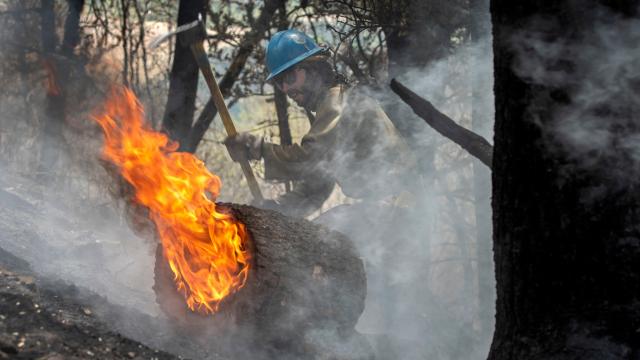The largest wildfire in New Mexico’s history is still burning. The Hermits Peak/Calf Canyon fire, which began in April, has covered more than 341,471 acres so far. The fire has destroyed hundreds of homes, burned through important cultural sites and resources, and forced thousands of people to evacuate — some whom are are still under evacuation warnings.
Progress has been made, though, and the fire is now 72% contained. But the damage done to public trust is far from over — thanks in large part to the fact that the fire began with two intentional Forest Service burns. On Tuesday, the Forest Service released a report summarizing its internal review of what went wrong in New Mexico and how to avoid the same mistakes in the future. The report noted that agency and personnel errors related to weather forecasting, fire modelling, fuel risk assessment, and communication contributed to the tragic outcome.
While the fires eventually joined together on April 24 to become a fast-spreading, complex blaze, they started out as separate fires. The Calf Canyon wildfire began as a prescribed “pile” burn of brush and thinned vegetation in January, which lay dormant for months, smouldering underground until conditions were right for it to blossom. The Hermits Peak fire, meanwhile, started as a prescribed burn on April 6, which was officially declared out of control just a few hours after it was ignited. The two fires joined together on April 24 to become a fast-spreading, complex blaze.
In the report, the Forest Service said the agency will learn lessons from how these prescribed burns got out of control. However, the report also emphasised that prescribed burns remain critical — especially under climate change, as wildfires become higher risk, more widespread, and more severe. Simultaneously, the report noted that climate change is making it more difficult to safely set intentional fires and that the Forest Service isn’t equipped to deal with the big changes.
“Climate change is leading to conditions on the ground we have never encountered,” Forest Service Chief Randy Moore said in the report’s foreword. “We know these conditions are leading to more frequent and intense wildfires. Drought, extreme weather, wind conditions and unpredictable weather changes are challenging our ability to use prescribed fire as a tool to combat destructive fires. Fires are outpacing our models and…we need to better understand how megadrought and climate change are affecting our actions on the ground.”
Lots of research has shown that prescribed burns are an instrumental strategy for managing landscapes and minimising the most catastrophic wildfires. Many ecosystems across the U.S. also depend on frequent fire to keep things balanced. But for decades, the prevailing forest practice in the U.S. was to aggressively suppress any and all fires, creating more fuel for fires to spark. The Forest Service has been working its way through that backlog, trying to restore a more ideal fire state to U.S. forests via prescribed burns in recent years.
But as the Hermits Peak/Calf Canyon fire shows, the prescribed burn strategy can backfire. In response, on May 20, the Forest Service announced a temporary pause on all prescribed burns set to last through most of August.
The Forest Service report revealed that the agency didn’t just misunderstand how climate change is impacting conditions — it erred in other ways, too. The fire was set amid a weather “roller coaster,” and fire crew leaders dismissed concerns about wind speed. The closest local remote weather station hadn’t been maintained well enough to rely on for accurate readings. Other mistakes, like lighting the fire despite an excess of burnable fuel, infrequent weather check-ins, testing the burn in an area that didn’t represent fire conditions, and a misallocation of resources also helped the fire get out of control.
The agency further said it underestimated what would be at stake if things went wrong: houses, the drinking water supply, prehistoric heritage sites, endangered animal habitat, rural communities. The report included suggestions for avoiding these mistakes in the future — for example, more remote weather stations — but offered no word on who within the Forest Service, if anyone, will be held accountable.
President Biden announced on June 11 that the federal government would cover the cost of recovery for those impacted by the fire: FEMA will pay for 100% of temporary housing and cleanup costs in the first 90 days post-wildfire. But many of the fire victims are still hurting financially, trapped by things like insurance limitations, according to reporting by the New York Times.
“They undervalued my community. They undervalued our homes. They undervalued our history. They undervalued mi gente,” said U.S. Congresswoman Teresa Leger Fernandez, who represents the northern New Mexico district affected by the blaze, in an article by Source New Mexico. “We know that the prescribed burns are important for managing our forests and, because of the mistakes that we have made over 100 years, we need to undo our mistakes. And prescribed burns are part of that. But we need to learn how to do them in a way where we’re reassured that they are as safe as possible.”
For Leger Fernandez, the internal Forest Service and investigation isn’t sufficient. Earlier this month, she requested an external review by the General Accountability Office that could lead to congressional hearings and take more than a year to complete.
Editor’s Note: Release dates within this article are based in the U.S., but will be updated with local Australian dates as soon as we know more.
